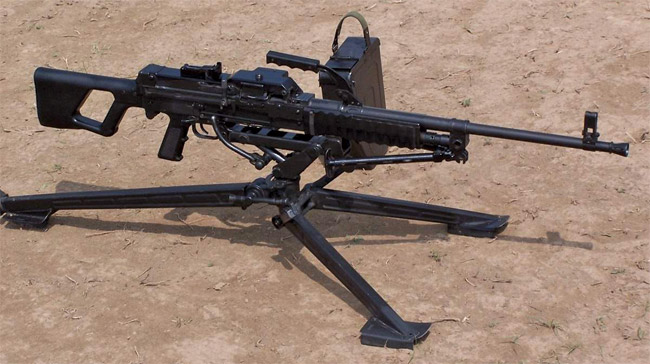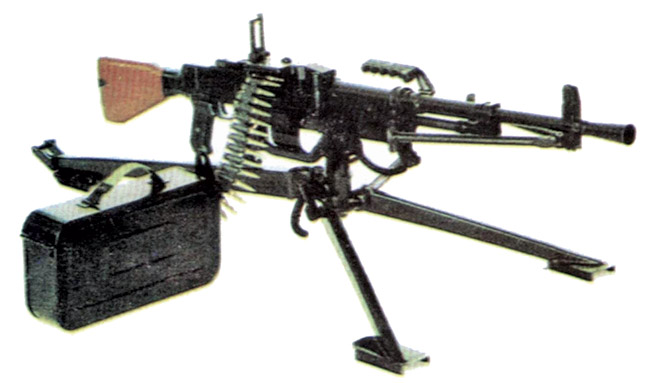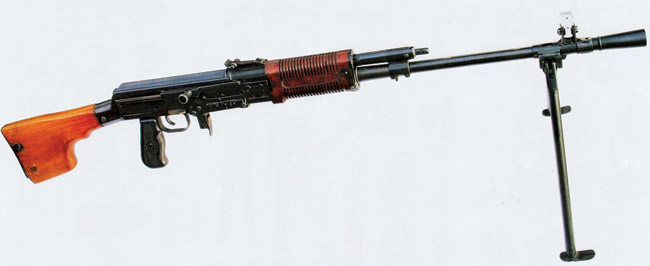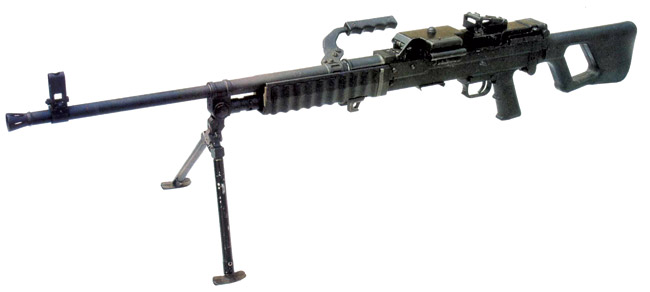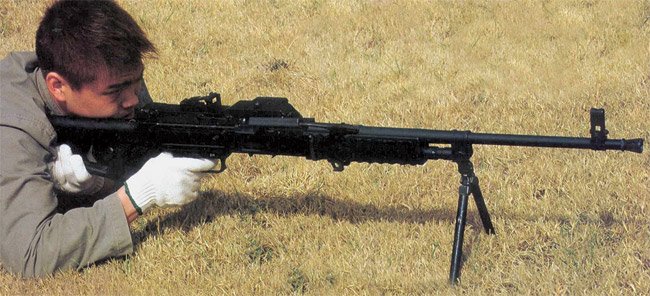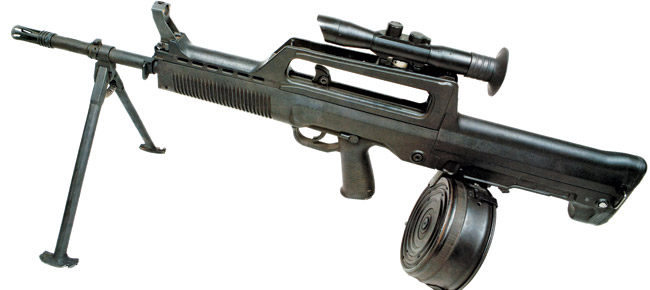PART ONE: RIFLE CALIBER WEAPONS
ABOVE: PLA soldiers practicing with Type 67-2 GPMG (front) and Type 81 LMG (in background).
Up until the 1960s, all machine guns manufactured in China were of foreign design. Earliest of these were well known copies of the German Maxim MG 08, generally known as Type 24 machine guns, chambered for 7.9mm Mauser ammunition of German origin. Lesser known weapons were locally made copies of the Browning M1917 and Schwarzlose M1907/12 machine guns, made between the two World Wars in very limited numbers. Light machine guns included domestic copies of Czechoslovak ZB-26 and ZB-30, as well as the Swiss SIG KE-7 machine guns, also chambered for 7.9mm Mauser ammunition.
When the communists took over mainland China in 1947, they switched to Soviet-pattern weapons, producing a number of Soviet designs using machinery, plans and technical assistance provided by the Soviet Union. These weapons included local copies of the Degtyarov DPM and RP-46 light machine guns in 7.62x54R, Goryunov SGM medium machine guns in the same caliber, and Degtyarov RPD light machine gun in 7.62×39.
It is hard to imagine the shape of the world had the close relations and warm friendship between the USSR and China continued up to the present. However, because of the political changes initiated after Stalin’s death by the new Soviet leader Nikita Khrushchev during the late 1950s and early 1960s, the relationship quickly cooled down and soon friendship was forgotten. Political disputes based on different views on Communists ideology and Stalin’s cult of personality split the two states like a sword. The former allies started a series of border disputes that included human wave attacks, tank incursions and the use of artillery and rocket salvos. In most of these encounters, Chinese soldiers had their butts handed to them by numerically inferior, but far better trained and motivated Soviet troops. From that time, Chinese small arms manufacturers were left on their own in the hard task of supplying the huge and poorly-trained conscript Chinese army with new weapons and equipment.
It is believed that at about that time the Chinese political leaders decided that copies of foreign weapons are good only for foreign users; there is nothing wrong in making some yuans or dollars by selling copies of foreign weapons to foreigners, but domestic demand must be satisfied with indigenous arms of Chinese origin. Most probably, the first Chinese military weapon developed and adopted under this concept was the Type 63 assault rifle. The first indigenous machine gun to be adopted by the PLA was the Type 67 universal (general purpose) machine gun.
Work on the new medium machine gun commenced in about 1959, with the intention of replacing the somewhat obsolete machine guns of Soviet design. First prototypes were ready by 1963, and, according to official Chinese reports, proved to be superior to existing weapons. At about the same time PLA experts received their first samples of the U.S. M60 general purpose machine gun from Vietnam. Close examination proved the value of the general purpose machine gun (GPMG) concept to Chinese experts, and the new machine gun was redesigned from the medium to the universal role. While the entire weapon was an original design, most of its parts were copies or adaptations of previous foreign designs, all of which were made in China before. There was a sound rationale behind this “Frankenstein” design. First, a lot of effort was saved in the design of many parts, as copying is always faster than designing new components; second, and not less important, was the fact that the “copycat” parts of the new gun could be produced on existing machinery and with existing tools and gauges, originally used for earlier guns. The Type 67 combined parts and features of guns like ZB-26 (bolt group), Maxim (belt feed), RPD (gas regulator), and SGM (removable barrel with adjustable headspace). The basic design, which was adopted for PLA service in 1967, went through several modifications, first in 1978 (type 67-1) and then in 1982 (Type 67-2). This weapon is still the primary company- and platoon-level machine gun of the PLA.
The general dissatisfaction with the 7.62×39 Type 56 (Degtyarov RPD) LMG / squad automatic weapon resulted in the development of a new light machine gun, which took place during the 1970s. This initially resulted in the Type 74 LMG, which, while being somewhat similar in appearance to Soviet Kalashnikov RPK LMG, was of completely original design. It seems that the Type 74 LMG was never adopted on a large scale and only small numbers of this weapon were produced for troop trials (which, according to Chinese sources, proved this weapon to be inherently inaccurate).
Further PLA plans apparently included adoption of a new infantry small arms system, which would consist of a standard infantry assault rifle and a machine rifle / squad automatic weapon, based on the same design. Such a system appeared in 1981, in the form of the Type 81 assault rifle and Type 81 light machine gun, both chambering the 7.62×39 Soviet cartridge. The Type 81 rifle bore certain resemblance to the Soviet Kalashnikov AKM rifle, and, similarly, the Type 81 LMG looked somewhat like the Kalashnikov RPK. It must be noted, however, that internally these weapons were different from the Kalashnikov, being of more or less indigenous design. Tactically, these weapons were on par with their Soviet counterparts. Like the RPK, the Type 81 LMG also lacked a quick-replacement barrel facility and used a large-capacity drum magazine. This combination of assault rifle and squad automatic weapon became the primary infantry armament of the PLA for the following decades.
At about the same time the Chinese army decided to pursue the worldwide trend towards smaller caliber, low impulse ammunition for infantry small arms. A development program, which commenced during the late 1970s, centered on cartridges of calibers between 5.6 and 6 millimeters; again, foreign cartridges of the same class, the 5.45×39 Soviet and 5.56×45 U.S. were ruled out of the competition from the start, most probably due to political reasons, despite the fact that both types of ammunition were already produced in China for export. The final design of the cartridge appeared in 1987. It was a new design, with a nominal caliber of 5.8mm (actual bullet diameter 6mm), and with a lacquered steel case 42mm long, officially known as the DBP87. Early military tests were conducted with the Type 87 assault rifle, a small-bore adaptation of the 7.62mm Type 81 rifle. Having selected the new ammunition, Chinese immediately began development of an entire family of infantry small arms, with the intention of replacing both 7.62×39 and 7.62x54R rifles and machine guns then in service. The new generation of Chinese small arms included a sniper rifle, an assault rifle / carbine / squad automatic family, and a general purpose belt-fed machine gun, all firing the same ammunition. Since the original DBP87 cartridge proved to be satisfactory only at ranges of up to 400 meters, Chinese experts developed a special ‘sniper / machine gun’ version of the basic round, loaded with a heavier, longer bullet with better geometry. This ‘long range’ cartridge is said to be compatible with standard DBP87 in all weapons, although long-range trajectory will be certainly different for either round. Recently, the Chinese press announced development of the new, all-purpose DBP10 5.8mm cartridge, with better long range capabilities than the original DBP87. Detailed specifications of this new round are yet to be discovered.
According to type designations, the first weapons to be adopted in this new caliber were QBU-88 (Type 88) sniper rifle and QJY-88 (Type 88) universal machine gun. However, the PLA apparently delayed issuing these arms until the completion of the development of the standard infantry rifle and squad automatic weapon. These weapons were adopted in 1995 as QBZ-95 (Type 95) assault rifle and QBB-95 (Type 95) light machine gun. These new weapons were first observed in 1997, when a Chinese garrison entered Hong Kong, after its return to Chinese administration. The Type 95 family of small arms is intended to replace all 7.62×39 rifles and light machine guns still in service with the PLA, and probably the PAP (Chinese police). What is more interesting; it seems that new Chinese doctrine has no place for a “full power” sniper rifle / machine gun cartridge like the 7.62×51 NATO or 7.62x54R Russian. All infantry needs are to be fulfilled with a single 5.8×42 cartridge – a sensible decision, at least from the logistical point of view. However, there will be a significant gap in the ammunition power spectrum between the 5.8×42 and the 12.7×108 heavy machine gun cartridge, and it is yet to be seen if this gap will put Chinese troops to any tactical disadvantage.
Type 67 universal machine gun
The Type 67 machine gun is a gas operated, air cooled, belt fed machine gun that fires from an open bolt and in automatic mode only. The barrel is fluted and quick-detachable. The Type 67 uses a ZB-26 type vertically-tilting bolt to lock the barrel. The gas system features an RPD-type gas regulator, and the trigger unit is generally patterned after the Soviet DPM machine gun.
The feed is from the right side only, using steel, non-disintegrating belts with open pockets (type 67-2 belts are assembled from 25-round pieces using the cartridge as an inter-link). To avoid using the two-stage feed that is usual with rimmed ammunition, the Type 67 uses a push-out type feed, where cartridges are pushed down and out of the link by cams in the feed module, then fed forward and into the chamber by the closing bolt. The standard belt capacity is 250 rounds, but for the LMG role 100-round belts can be loaded into a drum-type container that can be clipped to the receiver. The belt is said to be incompatible with any other weapon. The design of the belt traction unit has a certain resemblance to the Czechoslovak Vz.59 machine gun.
Furniture (pistol grip and shoulder stock) is made from wood. Original Type 67 machine guns were fitted with an integral, non-detachable, folding bipod, attached to the gas tube. For sustained or long-range fire missions, the Type 67 can be installed on an infantry tripod. Sights are of the open type, with a fully-adjustable rear sight; additionally, a special base for an anti-aircraft rear sight is installed at the front of the receiver, just ahead of the feed cover.
Modifications
Type 67-1: Barrels with a plain (non-fluted) profile; the bipod is clamped to the barrel (below the front sight) and can be easily removed. Furniture is made from plastic instead of wood.
Type 67-2: Barrels also of plain, non-fluted profile, and somewhat lighter than on earlier models. A new tripod is issued with the Type 67-2, which is significantly lighter because it uses stamped steel instead of steel tubing for the legs. Provisions are made for the installation of a telescope or night sight. On late production Type 67-2 guns the AA sight base is omitted.
Type 74 light machine gun
The Type 74 light machine gun is a gas operated, magazine fed, air cooled weapon, which fires from an open bolt. The gas system is located above the non-removable barrel, and consists of a gas block with a four-position gas regulator, a gas piston tube and a gas piston. Locking of the barrel is achieved by the laterally tilting bolt, apparently copied from the Soviet SGM machine gun. The cocking handle and ejection port are located on the right side of the stamped steel receiver, and fitted with separate dust covers.
The feed is from magazines; the standard magazine is a 100-round drum. Alternatively, Type 56 assault rifle (Kalashnikov AK) 30-round magazines can be used.
The Type 74 LMG is normally fitted with a non-detachable folding bipod mounted below the front sight base on the barrel. The pistol grip and handguard are made from plastic while the buttstock is made from wood.
Type 81 light machine gun
The Type 81 is a gas operated, magazine fed, selective-fired machine rifle / light machine gun. It uses a short-stroke gas piston located above the barrel and a two-position gas regulator. The Type 81 fires from a closed bolt. The gas system, as well as the bolt group with the three lug rotating bolt, is reminiscent of that of the Type 63 rifle. The Type 81 LMG also retains the bolt hold-open device, which catches the bolt in the open position after the last round has been fired from the magazine. The fire selector / safety switch is located at the left side of the receiver, just above the pistol grip, and can be easily operated with the right hand thumb. The open sights are marked from 100 to 500 meters, with the front sight being mounted on the muzzle end of the barrel. Ammunition is fed from 75-round drum magazines or from 20- and 30-round curved box magazines intended for the Type 81 assault rifle. Furniture (handguard, pistol grip and buttstock) is made from wood; additionally, a folding carrying handle is provided at the center of mass of the weapon. A folding bipod is permanently attached to the barrel, just behind the front sight base.
Modifications
WQ 112: an export version of the Type 81, adapted for Type 56 (Kalashnikov AK) compatible magazines, and with minor cosmetic changes in furniture.
Type 88 (QJY 88) universal machine gun
The QJY 88 is a gas operated, air cooled, belt fed machine gun with a quickly-detachable barrel. It fires from an open bolt in automatic mode only. The design is rather conventional, with a long-stroke gas piston, located below the barrel, which operates the bolt group with a rotary locking bolt. The feed is from non-disintegrating steel belts from the left side only. Belt is of open-pocket type, with single step, push-trough feed. A special plastic container can be attached to the left side of receiver, or below it, to hold the belt while on the move. The gun is fitted with a skeletonized shoulder stock, made of polymer, and an integral folding bipod attached to the gas block. For sustained fire missions, the QJY 88 can be installed on a special lightweight tripod. The standard sights are of the open type, but a telescopic or IR sight can be attached to the weapon if required.
Modifications
QJT 88: vehicle (tank) version of the basic weapon. It has a heavier barrel with a longer flash hider and is fitted with an electric solenoid trigger that replaces the buttstock.
Type 95 (QBB 95) light machine gun
The Type 95 is a gas operated, selective fire, air cooled, light machine gun, which fires from closed bolt. It uses a short stroke gas piston located above the barrel. The rotary bolt has three lugs that lock into the barrel extension. The receiver is made from polymer and is of a bullpup layout. The charging handle is located at the top of the receiver under the carrying handle. The safety / fire mode selector switch is located at the left side of the buttstock, close to the rear end of the weapon. Ejection is to the right side only. The standard magazine is a proprietary 80-round drum with an asymmetrically located mouth. The QBB-95 can also accept standard 30 round box magazines from the QBZ-95 assault rifle.
Modifications
Type 95-1: An improved version of the basic weapon developed from the Type 95-1 assault rifle. Major changes include more ergonomic manual safety / fire mode selector switch relocated to the top of the pistol grip, manual gas regulator, strengthening of certain parts, and improved ejection pattern (forward and to the right), which allows to fire the weapon from the left shoulder more or less safely.
Type 97: An export version of the QBB-95 that is offered through the NORINCO Corporation. It is basically the same weapon but adapted to fire the 5.56x45mm NATO cartridge from M16-compatible (STANAG) magazines.





